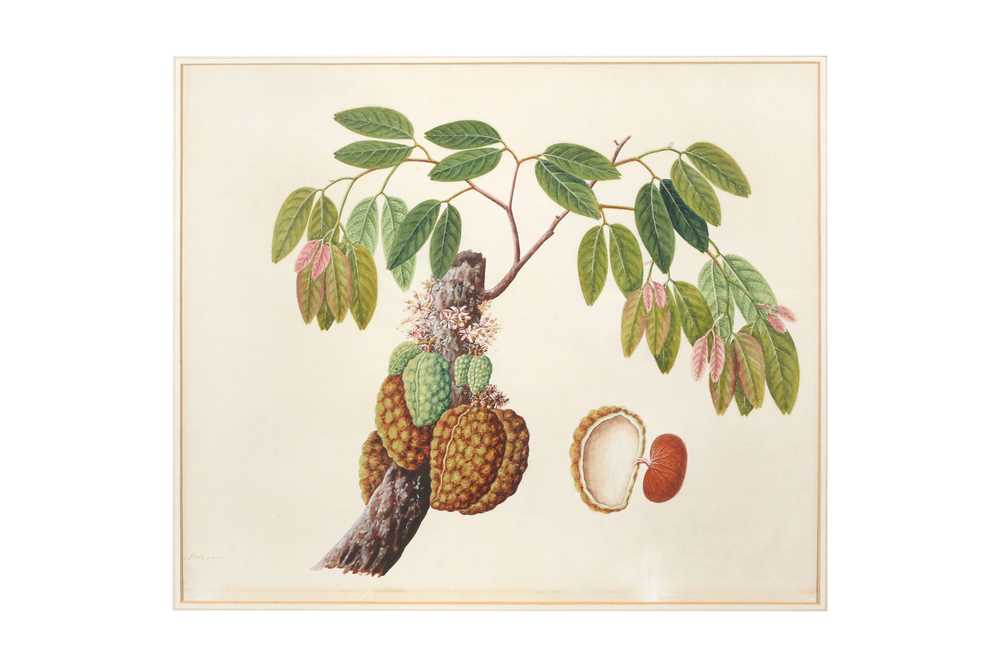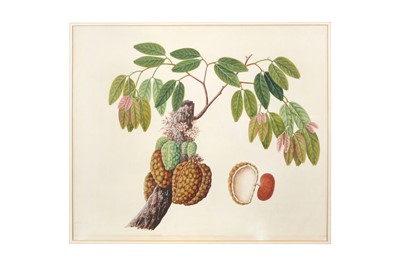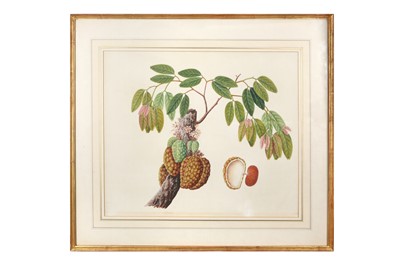29th Apr, 2022 13:00
Islamic & Indian Art
A COMPANY SCHOOL BOTANICAL STUDY OF A PLANT WITH A CLUSTER OF FRUITS
Kolkata (Calcutta), West Bengal or South East Asia, first half 19th century, probably by a Chinese artist
A COMPANY SCHOOL BOTANICAL STUDY OF A PLANT WITH A CLUSTER OF FRUITS
Kolkata (Calcutta), West Bengal or South East Asia, first half 19th century, probably by a Chinese artist
Opaque pigments, white wash and ink on wove paper, the horizontal composition depicting a study of a plant from the Moraceae family, possibly a jackfruit (Artocarpus heterophyllus) or breadfruit (Artocarpus altilis), bearing ripe fruits grouped in the middle of a short trunk with a dense treetop with a slimmer foliate branch stretching outward with both young and mature ova leaves, differentiated in palette and size, on the lower left corner a faded sepia ink inscription possibly with the Latin name of the plant specimen, the pictorial technique reminiscent of Chinese artists' Company School productions mixing Western-inspired botanical drawings with locally available, autochthonous species, mounted on a white cardboard panel, glazed and framed, the painting 43cm x 49cm, 62cm x 66.5cm including the frame.
Among the different styles and groups of artists, the term 'Company School' refers to, there is a small group of botanical studies usually attributed to Chinese artists working for British patrons, who, though inspired by their Indian counterparts, painted natural subjects in a more fluid and almost naive manner. Another main feature that helps scholars link these botanical studies to Chinese artists is the subject of the composition: in this group, most plants and fruits are native to South East Asia rather than India.
Our painting of the jackfruit plant presents several similarities with the brush style, palette, subject matter, and paper quality of a group of seven botanical studies once part of the Carlton Rochell Collection of Company School Paintings, including a cross-section of a large jackfruit, attributed to a 19th-century Chinese artist active in South East Asia (Sotheby's London, 27 October 2021, lot 28). The depiction of the foliage, the lack of well-defined contouring lines and the translucent quality of the wove paper present analogous traits, linking our study to a similar attribution exhibiting hybrid Indo-Chinese influences. As a matter of comparison, to highlight the different style and rendering of Indian botanical studies of the same subject, please see Bonhams Knightsbridge, 26 February 2020, lots 99 and 100.
(Quantity:1)
Dimensions: the painting 43cm x 49cm, 62cm x 66.5cm including the frame
Do you have an item similar to the item above? If so please click the link below to request a free online valuation through our website.



